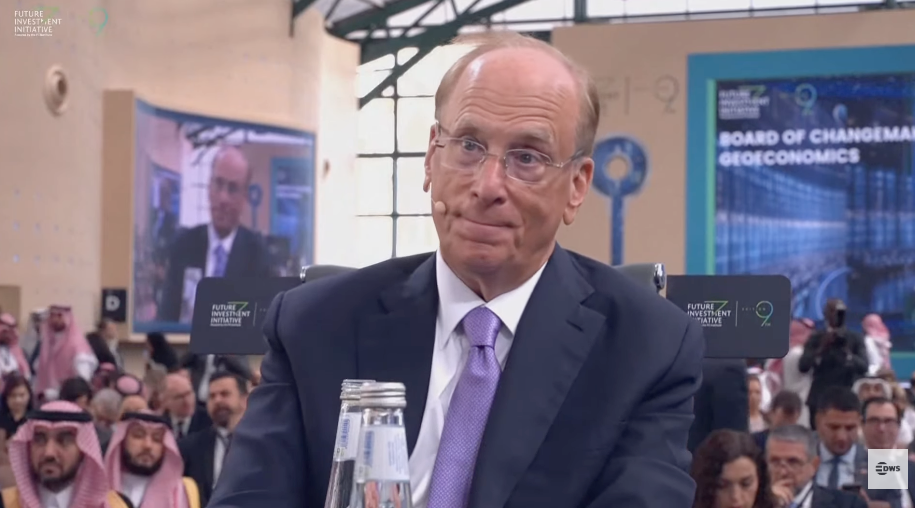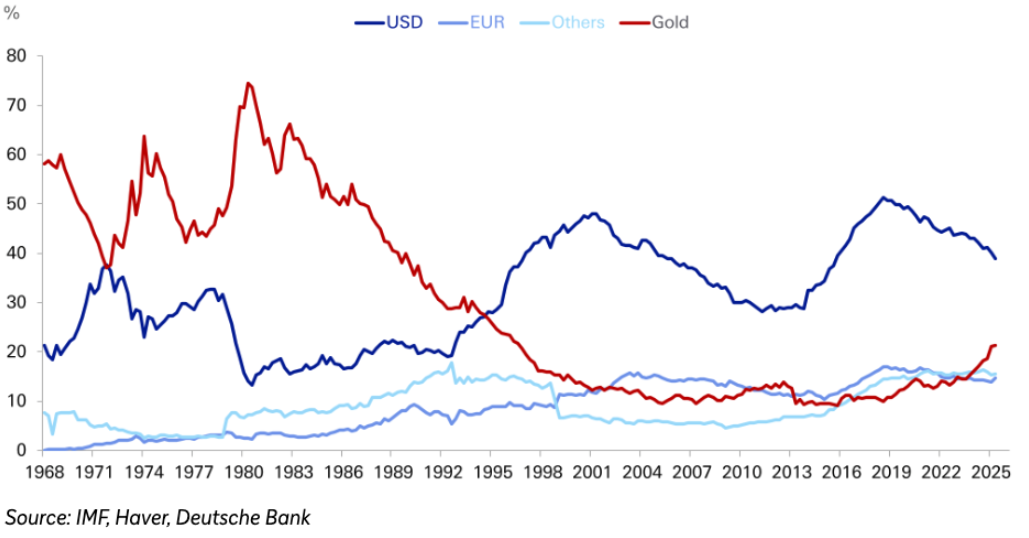BlackRock CEO Larry Fink describes cryptocurrency and gold as “assets of fear,” bought by investors worried about asset debasement amid global financial instability. Central banks are increasing gold reserves, while tokenization poses key questions for future finance. Fink highlights U.S. reliance on foreign Treasury buyers as a major concern.
-
Assets of fear: Fink says crypto and gold purchases stem from fears of devaluing fiat currencies and unstable global security.
-
Gold prices recently dropped below $4,000 after peaking above $4,377, reflecting market volatility.
-
Central banks’ gold holdings reached 24% of reserves in Q2 2025, per Deutsche Bank data, signaling a shift toward traditional safe havens.
Discover why BlackRock’s Larry Fink calls crypto and gold “assets of fear” in uncertain times. Explore tokenization’s role and central bank trends—read insights on financial stability and investment strategies today.
What Are Crypto and Gold as “Assets of Fear” According to BlackRock CEO Larry Fink?
Crypto and gold as “assets of fear” refer to investments driven by investor anxiety over the potential devaluation of traditional assets like fiat currencies amid geopolitical and economic uncertainties. BlackRock CEO Larry Fink explained this during a panel at the Future Investment Initiative conference in Riyadh, Saudi Arabia, emphasizing that people buy these assets out of fear for the financial and physical security of their wealth. He noted that such purchases signal broader concerns about global stability, where investors seek protection against inflation and currency debasement.
The remarks underscore a growing trend where alternative assets gain traction during turbulent times. Fink’s perspective aligns with observations from financial markets, where both cryptocurrencies and precious metals have historically served as hedges against systemic risks.

BlackRock CEO Larry Fink at the Future Investment Initiative in Riyadh. Source: YouTube
How Is the U.S. Economy’s Dependency on Foreign Investors Impacting Financial Stability?
The U.S. economy’s heavy reliance on international buyers for up to 35% of Treasury sales poses significant risks to financial stability, as highlighted by Fink. This dependency creates vulnerability if foreign demand wanes, potentially leading to a multiplier effect on interest rates and borrowing costs. Fink urged policymakers to unlock private capital to reduce this exposure, drawing on data from U.S. Treasury reports that show ongoing foreign purchases stabilizing debt markets.
Expert analysis from economic think tanks like the Brookings Institution supports this view, noting that shifts in global investor sentiment could exacerbate U.S. fiscal challenges. Short sentences for clarity: Foreign inflows fund deficits. A sudden drop could spike yields. Diversifying funding sources is essential. Central banks worldwide monitor this dynamic closely, as it influences broader dollar hegemony.
At the same event, Fink addressed surging central bank gold acquisitions, which have reshaped reserve strategies. According to World Gold Council figures, global central banks added over 1,000 tons of gold in 2025 so far, driven by diversification away from U.S. dollar assets. This trend, evident in actions by institutions like the People’s Bank of China and the Reserve Bank of India, reflects strategic hedging against inflation and geopolitical tensions.

Gold’s share of central bank reserves reached 24% in Q2 of 2025. Source: Deutsche Bank
Fink pointed out that central banks are grappling with tokenization’s implications. “The biggest question from central banks is what role tokenization and digitization will play,” he stated, referencing challenges in modernizing payment systems and currencies. This includes debates on central bank digital currencies (CBDCs) and their potential to disrupt traditional finance. Reports from the International Monetary Fund indicate that over 90% of central banks are exploring CBDCs, with tokenization accelerating asset transfers and reducing intermediaries.
“I think we spend so much time talking about AI. We’re not spending enough time talking about how quickly we’re going to tokenize every financial asset,” Fink added. He predicted rapid global adoption, warning that many nations are unprepared for technology’s transformative speed. This aligns with BlackRock’s own initiatives, such as its tokenized money market fund on Ethereum, which demonstrates practical applications in blockchain-based finance.
As the world’s largest asset manager with over $10 trillion in assets under management, BlackRock’s involvement in cryptocurrency is notable. Its iShares Bitcoin Trust, as of late October 2025, holds approximately 805,806 BTC, representing a substantial portion of institutional Bitcoin exposure. This positions BlackRock as a key player in bridging traditional and digital assets, solely on behalf of clients seeking diversified portfolios.
Fink’s views on tokenization echo his earlier statements that all financial assets could be digitized in the coming decades. Industry experts, including those from JPMorgan, estimate that tokenization could unlock $4 trillion in illiquid assets by 2030, enhancing liquidity and efficiency. However, regulatory hurdles remain, with bodies like the U.S. Securities and Exchange Commission emphasizing the need for robust frameworks to mitigate risks such as cyber threats and market manipulation.
Bitcoin’s role as an inflation hedge has been debated, with research from New York Digital Investment Group suggesting it performs better during dollar weakness rather than pure inflation scenarios. This complements Fink’s “assets of fear” narrative, where crypto joins gold in investor flight-to-safety moves. Central banks’ gold rush, meanwhile, counters de-dollarization efforts, as seen in BRICS nations’ discussions on alternative reserve baskets.
The interplay between these trends highlights evolving global finance. Investors must navigate volatility: Gold’s recent tumble below $4,000 from $4,377 highs, per TradingView charts, illustrates short-term pressures from interest rate expectations. Yet, long-term demand persists, bolstered by central bank buying that has kept annual averages above 700 tons since 2022.
Frequently Asked Questions
What Does Larry Fink Mean by Crypto and Gold as “Assets of Fear”?
Larry Fink means that investors purchase cryptocurrency and gold when fearing the debasement of fiat currencies and threats to asset security amid economic and geopolitical instability. These assets act as protective measures, reflecting broader anxieties about financial systems, as evidenced by increased holdings during market downturns.
How Is Tokenization Changing Central Bank Strategies?
Tokenization is transforming central bank strategies by enabling faster, more secure digitization of assets and currencies, which could enhance payment efficiency and reduce costs. Banks are evaluating its impact on systems like SWIFT and the U.S. dollar’s dominance, with pilots showing potential for real-time settlements that sound seamless in voice searches: “Tokenization streamlines global transactions while raising questions on privacy and adoption.”
Key Takeaways
- Investor Fear Drives Demand: Crypto and gold surge as safe havens when stability wanes, per Fink’s analysis, urging diversified portfolios.
- U.S. Treasury Risks: Dependency on 30-35% foreign sales heightens vulnerability; unlocking private funds could mitigate multiplier effects on the economy.
- Tokenization’s Urgency: Rapid digitization of assets is imminent—governments must prepare to avoid disruptions in finance.
Conclusion
In summary, BlackRock CEO Larry Fink’s portrayal of crypto and gold as “assets of fear” captures investor responses to devaluation risks, while central banks’ gold hoarding and tokenization queries signal shifting financial paradigms. These developments, supported by data from sources like the World Gold Council and IMF, emphasize the need for adaptive strategies. As tokenization accelerates, staying informed on these trends will empower investors to navigate future uncertainties—consider reviewing your asset allocation today for enhanced resilience.






